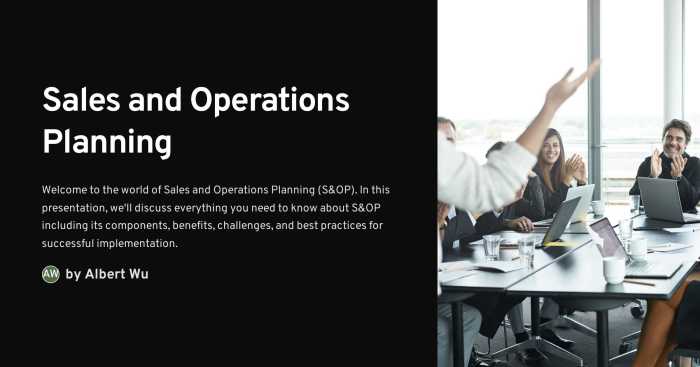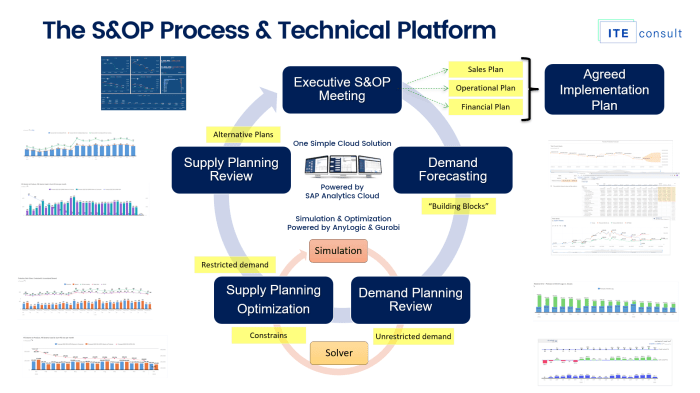Sales and operations planning software is revolutionizing business strategies by providing a centralized platform for aligning sales forecasts with operational resources. This powerful tool enables businesses to optimize production, inventory management, and resource allocation, ultimately leading to improved profitability and reduced costs.
By integrating data from various departments, this software offers a holistic view of the entire business operation. Real-time insights and predictive analytics help anticipate market trends and proactively adjust strategies, ensuring businesses stay ahead of the curve.
Sales and Operations Planning (S&OP) software is a crucial tool for businesses looking to optimize their operations and achieve greater profitability. This comprehensive guide delves into the intricacies of S&OP software, exploring its features, benefits, and how it can revolutionize your business strategies. We’ll also examine different types of S&OP software, considerations for implementation, and answer frequently asked questions.

Source: gamma.app
Understanding Sales and Operations Planning (S&OP)
S&OP is a structured process that aligns sales forecasts with operational capabilities. It bridges the gap between marketing and production, ensuring that the company’s resources are utilized effectively to meet anticipated demand. This process involves multiple departments, including sales, marketing, finance, and operations. Effective S&OP processes result in improved inventory management, reduced costs, and enhanced customer satisfaction.

Source: ite-consult.com
Key Components of a Robust S&OP Process
- Demand Forecasting: Accurately predicting future sales.
- Production Planning: Optimizing production schedules based on demand.
- Inventory Management: Ensuring optimal inventory levels to meet demand and minimize holding costs.
- Capacity Planning: Assessing and adjusting resources to meet demand.
- Financial Planning: Integrating financial considerations into the planning process.
Sales and Operations Planning Software: Features and Benefits
S&OP software streamlines the S&OP process, automating many tasks and providing valuable insights. Key features include:
Forecasting Tools, Sales and operations planning software
- Historical data analysis: Utilizing past sales data to predict future trends.
- Statistical modeling: Applying statistical techniques to refine forecasts.
- Scenario planning: Evaluating various potential scenarios to identify the most likely outcomes.
Collaboration and Communication Tools
- Centralized data repository: Providing a single source of truth for all relevant data.
- Real-time data updates: Ensuring everyone has access to the latest information.
- Interactive dashboards: Visualizing key performance indicators (KPIs) and facilitating data-driven decision-making.
Optimization and Analysis Tools
- Resource optimization: Identifying and utilizing resources efficiently.
- Inventory optimization: Determining optimal inventory levels to minimize costs and maximize availability.
- Profitability analysis: Identifying areas for improvement in profitability.
Types of S&OP Software
Different S&OP software cater to various business needs and sizes. Some options include cloud-based, on-premise, and integrated software solutions. Choosing the right type depends on factors like budget, scalability, and existing infrastructure.
Implementing S&OP Software: Sales And Operations Planning Software
Successful implementation requires careful planning and execution. Key steps include:

Source: o9solutions.com
- Defining clear goals and objectives.
- Selecting the right software solution.
- Training employees on the new software.
- Data migration and validation.
- Ongoing monitoring and evaluation.
Frequently Asked Questions (FAQ)
- Q: How much does S&OP software cost?
A: Costs vary depending on the software provider, features, and company size. Contact potential providers for pricing details.
- Q: How long does it take to implement S&OP software?
A: Implementation timelines depend on the complexity of the process and the level of customization required.
- Q: What are the benefits of using S&OP software?
A: Benefits include improved forecasting accuracy, better inventory management, optimized production planning, and enhanced profitability.
- Q: What are some alternative solutions to S&OP software?
A: Manual processes and spreadsheets can be used, but they lack the efficiency and sophistication of dedicated software.
Conclusion
Sales and Operations Planning software is a powerful tool for businesses seeking to optimize their operations. By improving forecasting, communication, and resource allocation, S&OP software can drive profitability and enhance overall business performance. Implementing a robust S&OP process, with the aid of appropriate software, is crucial for achieving strategic goals and maintaining a competitive edge in today’s dynamic market.
Call to Action (CTA)
Ready to streamline your sales and operations planning? Explore our recommended S&OP software solutions and take the first step towards optimizing your business performance. Visit our website for more information and to request a demo.
Source: [Insert Links to reputable industry resources like Gartner, Forrester, etc.]
In conclusion, sales and operations planning software offers a comprehensive solution for businesses seeking to optimize their operations. By improving forecasting accuracy, streamlining resource allocation, and enhancing collaboration across departments, this technology empowers organizations to achieve greater efficiency and profitability. Further exploration into specific use cases and implementation strategies will reveal even greater potential for success.
FAQ
What are the typical costs associated with implementing sales and operations planning software?
Implementation costs vary significantly based on the chosen software, the size of the business, and the complexity of integration. Factors like customization, training, and ongoing maintenance contribute to the total expenditure. Detailed cost breakdowns are usually available from the software vendor.
How does sales and operations planning software improve inventory management?
By integrating sales forecasts with production plans, the software helps optimize inventory levels. It allows businesses to proactively adjust inventory based on predicted demand, reducing storage costs and minimizing stockouts or overstocking.
What are some key performance indicators (KPIs) to track after implementing sales and operations planning software?
Key performance indicators should focus on areas such as order fulfillment time, inventory turnover rate, production efficiency, and customer satisfaction. Tracking these metrics provides valuable insights into the effectiveness of the implemented software.